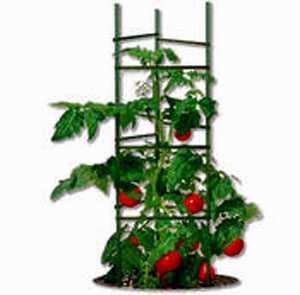How Many Plants?
As a rule of thumb, grow two plants for each member of the family who eats lots of tomatoes. If you are canning tomatoes or making fresh salsa, canned tomato or spaghetti sauce, use up to four plants per person. Read the plant tags to determine the tomato species which best suit your culinary interests - a mix might be best for those who want to use fresh tomatoes as well as those who may be planning to can tomatoes or make sauces for later use.
Sun Requirements and Site Selection
Tomatoes should receive full sun, generally seven hours or more daily, because they are a warm weather crop. Seven hours of sun will give them optimum growing conditions and will produce the greatest flavor. Morning sun is better than afternoon sun, so choose a location with that in mind if you don't have an area that can provide full sun. If your tomatoes are getting stretched out and leggy you probably do not have enough morning sun on your tomatoes.
Composting
Add lots of well-rotted compost to the soil before you plant tomatoes. Tomatoes require soil rich in organic nutrients. You can buy compost or make your own using Ringer Compost Plus Compost Starter. Composting is an easy way to attain nutrient rich soil while recycling grass clippings, yard "trash" and fruit and vegetable peels.
Prepping Your Transplants
Planting tomatoes requires you to sow your seeds indoors about 8 weeks prior to the last spring frost. Seedlings are safe to move outdoors roughly once overnight temperatures stop dropping below 50 degrees Fahrenheit. If planning that far ahead doesn't match your gardening style, most garden centers offer a wide variety of tomato plants that you can start with.
You can help your plants adjust to being transplanted by setting them outdoors in the sun for a few hours a day prior to planting them. This helps them to "harden off" and gives them a jump start on the transplanting process. Soil moisture in the transplant pots should be checked regularly during this period as they typically don't hold much water and can dry quickly in the sun.
Watering
Place your tomato plant deep in the soil, even burying some of the lower leaves. The plant will produce new roots along the buried stem and help the transplant to produce deeper roots.
Water your newly transplanted tomato plants immediately with about a gallon of warm water so that the plant can settle in and not experience transplant shock. Continue watering every day for the first week or so - about 16 ounces of warm water per plant.
Throughout the growing season water tomatoes with a drip or soaker hose rather than from an overhead water source. Tomatoes are more prone to some diseases when plants are watered from overhead.
After the tomatoes have been transplanted for a week or more, watering can be done less frequently, but plants should still be getting about two gallons of water a week, per plant. With hotter weather and larger plants, increased watering may be necessary if there is a dry period.

















Related Items
Indian coffee now widely loved across the globe...
Healing at Maha Kumbh, A story of medical care and commitment
'Wealthy donors more able to sway political decision-making now'